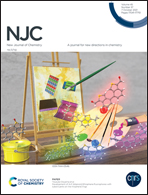Quantitative activity–activity relationship (QAAR) driven design to develop hydroxamate derivatives of pentanoic acids as selective HDAC8 inhibitors: synthesis, biological evaluation and binding mode of interaction studies†
Abstract
Histone deacetylase 8 (HDAC8) has been implicated as a potential drug target of many diseases including cancer. HDAC8 isoform selectivity over other class-I HDACs is a major concern nowadays. In this work, a series of pentanoic acid based hydroxamates with different substituted cap groups have been designed, synthesized, characterized, and screened against class-I HDACs. A quantitative activity–activity relationship (QAAR) model was developed to design HDAC8 selective inhibitors. The designed compounds obtained through the molecular modeling study were synthesized, characterized, and their enzymatic as well as cytotoxic activities were measured. Two compounds 7i and 7f are found to be selective HDAC8 inhibitors over other class-I HDACs. These compounds possess better antiproliferative activities against some cancer cell lines. These observations are in agreement with the molecular docking studies for the binding mode of interactions. Further studies show that compounds 7i and 7f induce significant cell growth arrest in the G2/M phase, indicating their anticancer potentials. In summary, our study confirms pentanoic acid based hydroxamate as selective HDAC8 inhibitors and two compounds 7i and 7f may serve as lead molecules for further investigation.



 Please wait while we load your content...
Please wait while we load your content...